Le
Mans 24 Hours 2007
A Beginners' Guide. June 14th 2007
An
Introduction to the Le Mans 24 Hour Race
By Adam Wiseberg, Motorsport Director of AD Holdings
Although
many of our trackside guests are keen followers of motor
racing, through F1 and other classes, sportscar racing
is a somewhat different discipline and we thought that
some explanation might be useful to Le Mans novices - although
please note that this introduction was first prepared
in 2007, and some technical elements may have changed
since then.
History
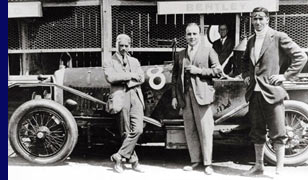 The
Le Mans 24 Hour race is run by the Automobile Club de l’Ouest
which is abbreviated to ACO. The ACO creates its own regulations
for Le Mans and for the spin-off series in Europe (the Le
Mans Series) and in North America (American Le Mans Series,
or ALMS). The ACO is an extremely powerful body that exercises
absolute control over the regulations for their flagship
event, the Vingt Quatre Heures du Mans. Le Mans ranks alongside
the Indianapolis 500 and the Monaco Grand Prix as one of
the most famous motor races in the world.
The
Le Mans 24 Hour race is run by the Automobile Club de l’Ouest
which is abbreviated to ACO. The ACO creates its own regulations
for Le Mans and for the spin-off series in Europe (the Le
Mans Series) and in North America (American Le Mans Series,
or ALMS). The ACO is an extremely powerful body that exercises
absolute control over the regulations for their flagship
event, the Vingt Quatre Heures du Mans. Le Mans ranks alongside
the Indianapolis 500 and the Monaco Grand Prix as one of
the most famous motor races in the world.
The
event was first held in 1923 on a circuit consisting of
public rounds to the south of the town of Le Mans. It has
been held annually since then apart from 1936 (Great Depression)
and between 1940 and 1948 (Second World War and its aftermath).
This will be the 75th running of the race.
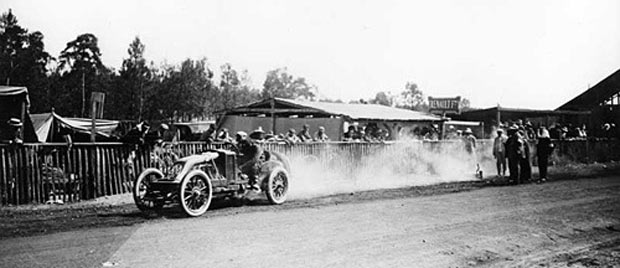
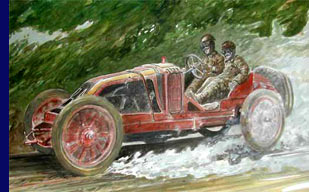 It
is worth noting that Grand Prix motor racing originated
in France (hence the French spelling) and that the French
Grand Prix is the oldest Grand Prix of them all. It was
first staged in June 1906 at Le Mans (above and right) and
a special centennial celebration was staged last year, with
period cars "racing" through the city streets.
That makes this year the 101st anniversary of motor racing
at Le Mans.
It
is worth noting that Grand Prix motor racing originated
in France (hence the French spelling) and that the French
Grand Prix is the oldest Grand Prix of them all. It was
first staged in June 1906 at Le Mans (above and right) and
a special centennial celebration was staged last year, with
period cars "racing" through the city streets.
That makes this year the 101st anniversary of motor racing
at Le Mans.
The
Rules
The ACO’s rules accept two categories: Prototypes
and Grand Touring Cars. Each
of these categories is further divided into two classes:
The
cars racing within each of these classes is effectively
competing in a race within a race. So, although the Aston
Martins, Corvettes and Saleens, for example, will be aiming
for the highest possible overall position, their real objective
is to be the first LM GT1 car across the finish line to
win their class.
Prototype
Category
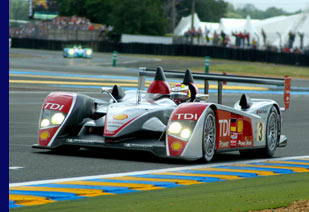 LMP1
LMP1
These cars must weigh a minimum of 925kg and their
engines have a maximum capacity of 4000cc if turbocharged,
or 6000cc if normally aspirated. They also have the widest
tyres, affording them the maximum grip levels.
With
the most powerful engines they also achieve the highest
maximum speeds. Some will reach over 330 kph on the Mulsanne.
Engines can be diesel or conventional petrol technology,
although the diesels have a smaller fuel capacity in an
attempt to compensate for their inherent power advantage.
The smaller fuel capacity forces them to come into the pits
more frequently to refuel. Carbon brake disks and pads enable
over 24 hours of running without replacing the friction
material. Expect a typical race lap to be down towards 3m
30s from the diesel powered cars, with the fastest petrol-engined
cars – the Pescarolos – about 2 seconds slower.
The fastest race lap could go as low as 3m 28s, and qualifying
pole could be as much as two seconds faster than this.
LMP2
The second category of prototypes must weigh a minimum of
725 kg and are powered by normally-aspirated engines of
a maximum of 3400cc, or turbocharged engines of 2000cc.
They are also restricted to smaller tyres than the LM P1
cars. They have a maximum fuel capacity of 90 litres. The
carbon brake disks and pads enable these cars to generate
incredible stopping power and drivers describe the feeling
of ‘hanging in their belts’ as the G force,
combined with the drivers weight, causes the seat belts
to stretch slightly. Typically, the RML MG-Lola can slow
from 300 kph to 90 kph in less than 80 metres!
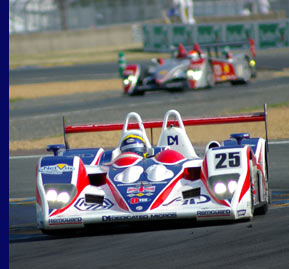 The
much greater power that the LM P1 engines generate more
than compensates for their greater weight. In addition the
larger tyres give them an additional performance advantage.
Nevertheless, in wet conditions, the more nimble nature
of the LM P2s due to their lighter weight may enable the
fastest of them to challenge some of the LM P1s. Watch out
for this if there is any rain during the race or qualifying.
Expect a typical lap time for the fastest LMP2s around 3m
45s whilst the fastest lap could be in the 3m 39s region.
The
much greater power that the LM P1 engines generate more
than compensates for their greater weight. In addition the
larger tyres give them an additional performance advantage.
Nevertheless, in wet conditions, the more nimble nature
of the LM P2s due to their lighter weight may enable the
fastest of them to challenge some of the LM P1s. Watch out
for this if there is any rain during the race or qualifying.
Expect a typical lap time for the fastest LMP2s around 3m
45s whilst the fastest lap could be in the 3m 39s region.
For
the prototype category there is no minimum quantity requirement
for production. Also, as this is a sportscar series, the
prototypes must have a cockpit which is notionally big enough
for two people and their wheels and tyres must be enclosed
by bodywork. They are currently allowed to be designed with
either open or enclosed cockpit areas. The enclosed design
of the Peugeots is likely to give them a small advantage
in overall straight-line speed over the Audis.
GT
Category
Both GT classes are based on production cars and, to be
eligible to race, a certain minimum number must have been
built. Thus prevents a manufacturer producing a one-off
design that meets the letter of the regulations but, being
effectively a prototype, could be much faster than the production
based designs.
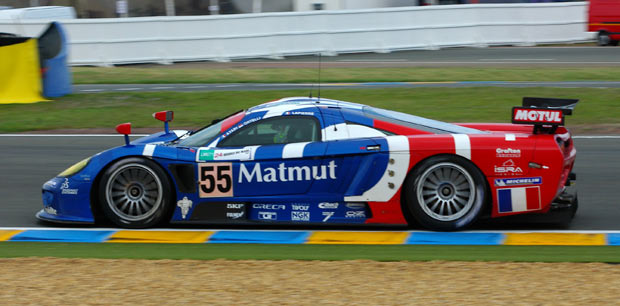
LM
GT1
This class allows significant modification from the original
road car specification although the basic shape must remain
the same albeit with the addition of a large rear aerodynamic
wing. These cars are usually built around a specially designed
and constructed tubular frame – the roll cage and
drive safety cell – which is then ‘clothed’
in bodywork panels made from ultra light carbon. This has
the effect of bringing the overall weight down to around
1100kg, which is almost 40% less than the road car. In addition,
modifications to the engine will increase the power by up
to 33% giving a total increase in power to weight ratio
of around 100%. Typically, a road version of the Aston Martin
DB9 can accelerate from 0-100 kph in about 5 seconds whilst
the race version will achieve the same test in about 2.5
seconds!
Pictured
above is the Saleen S7-R, designed and developed by RML
and raced at Le Mans in 2007 by the French Oreca team.
Amongst
the modifications which are allowed, the engine position
can be moved to give a more balanced weight distribution,
whilst carbon brakes, bigger wheels and tyres and modified
suspension and dampers transform the handling. Although
these cars will typically lap 10 seconds slower than the
LMP2 cars, their huge power advantage – the engines
can be up to 7 litres – makes them very difficult
for the smaller prototypes to overtake on the long straights.
A typical lap time may be as low as 3m 51s with a fastest
lap possibly below 3m 50s.
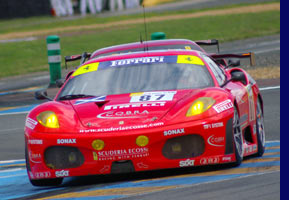 LM
GT2
LM
GT2
The regulations require these cars to adhere much
more closely to the production car on which they are based.
Each GT2 car will have been created from a production bodyshell
that will have had a safety roll cage added. Carbon fibre
is only allowed for removable bodywork such as the wings,
bonnet and doors.
The
engine must remain in its original position and suspension
modifications are far more restricted than with GT1. Expect
a typical race lap time to be around 4m 08s with a fastest
lap around 4m 02s.
Drivers
The rules allow a maximum of three drivers in each car.
The maximum time that any driver can drive for continuously
(i.e. without being replaced) is 4 hours. In addition no
driver may drive for more than 14 hours in total.
Strategy
Routine pit stops will be dictated by the fuel consumption.
Once the quantity of fuel in the tank is lower than that
required to complete another full lap the team will call
the driver into the pits. There the fuel will be replenished
and the car will rejoin the race. As the rules do not allow
any other work to take place on the car whilst refueling,
most teams will leave the same tyres on for a double stint
to save the time that it would take to change them. During
the night, when the temperatures are cooler, the tyres can
last longer, allowing some teams to give their drivers to
a triple stint. This gives the double benefit of saving
the time for two tyre changes and giving the resting drivers
longer to recover between stints.
Although
the rules allow driver changes to take place during a fuel
stop, most teams will be unwilling to change the drivers
unless they are also changing tyres at the same time as
it may not be possible to complete the driver change before
the fuelling is complete, in which case unnecessary time
would be lost.
It
is also useful to understand that, during the race, teams
in the same class may move to different fuel strategies
in order to make it more difficult to understand their relative
positions from the timing screens. This may be as a result
of utilising a safety car period to refuel before the tank
is empty. Also, in general, whenever a car has to pit for
repair work the team will usually refuel it at the same
time. Fuelling may only take place in the pitlane (not in
the garage) so don’t be surprised if you see a car
being refuelled and then pushed into the garage.
Pit
Lane
The maximum number of personnel allowed to work on a car
in the pit lane is four. In addition, there can be one man
allocated to assist the drivers getting out and into the
car and fastening their seat belts, plus an engineer to
upload the data from the car and a ‘manager’,
who will usually hold the ‘in’ board and will
be the person who releases the car back into the pit lane
when the work is complete and the pit lane is clear. There
is no restriction on the number of personnel who may work
on the car in the garage, so if any car requires major attention
you will usually see the crew push it into the garage.
Any
personnel in the pit lane or on the pit wall must wear fireproof
overalls.
All
garage doors must remain open whilst the car remains in
the race.
Factory
versus Private
The A.C.O. states that LM P2 and GT2 classes are intended
mainly for private teams and must have performances inferior
to those in LM P1 and LM GT1. The ACO’s intention
is that the overall performance should be in order of the
classes i.e. 1st level of performance: LM P1, 2nd LM P2,
3rd LM GT1 and 4th LM GT2.
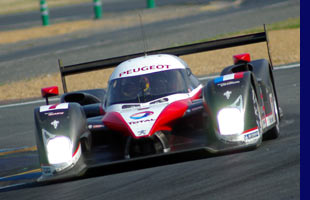 This
is crucial to understanding the difference between the classes.
In the LM P1 class there are two factory teams; Audi has
won Le Mans every year this century (2003 was won by Bentley
which is a VW Audi Group company, using technology taken
directly from the Audi R8) but this year faces a new challenge
from an old hand.
This
is crucial to understanding the difference between the classes.
In the LM P1 class there are two factory teams; Audi has
won Le Mans every year this century (2003 was won by Bentley
which is a VW Audi Group company, using technology taken
directly from the Audi R8) but this year faces a new challenge
from an old hand.
Peugeot
(left) is returning to endurance racing for the
first time since 1993, when the French manufacturer achieved
a clean sweep of the Le Mans podium with their all conquering
905 Evo 1C - widely considered to be the fastest ever sports
racing car. The factory teams have huge budgets and will
each have run several 24-hour race simulations, hiring a
circuit for their exclusive use and running their cars at
race pace for a full race distance. Because of their large
budgets they also have their pick of the available professional
drivers, and both Audi and Peugeot have ex Grand Prix drivers
galore in their line-ups.
The
story is similar in GT1 where big factory budgets have ensured
huge development programmes for both Aston Martin and Corvette,
together with stellar driver line-ups. These teams specialise
in bringing their cars home with minimal problems and fantastic
pace. The race for the GT1 lead will be as compelling as
the one at the head of the field and is well worth keeping
your eye on throughout the race. The factory Aston and Corvette
pits are immediately to the right of RML’s in the
pilane.
By
contrast with the factory classes, the LMP2 and LM GT2 classes
are intended for the privateer teams. These teams, funded
by private money, tend to differ significantly in make up
from the ones described above. Firstly, although many of
them employ professional drivers, they will almost all include
‘gentlemen drivers’ in their line-up. This is
the term applied to drivers who have a day job away from
racing and, rather than being paid to go racing, actually
bring funds to the team for which they drive. As a result,
many of these team’s performances may well be dictated
more by the pace of their ‘gentleman’, relative
to the next team’s, than by the overall potential
of the car.
Additionally,
because the cars in these two classes have not had the benefit
of full-scale factory support, there is more likelihood
of problems occurring during the race. This can have the
effect of turning them into a ‘last man standing’
competition, and that is exactly what happened last year
in LM GT2. The car which eventually won had been running
in 5th position for the greater part of the race and moved
up the order in the last few hours as its faster rivals
encountered problems.
Despite
the lack of factory money to the RML project, our two wins
in 2005 and 2006 gives the team knowledge that could pay
dividends in the longer term. Even if some of our rivals,
with their newer designs, are able to run at a faster pace
during the opening laps, the professionalism of the RML
crew should show through as the race wears. Nevetheless,
the following quote from Dindo Capello, multiple winner
of the race and one of the three drivers in the #2 Audi
sums it all up :-
“It
is difficult to make a forecast because it is such a long
race. It happens only once a year and everything has to
run perfectly that day. If it doesn’t, you have to
wait 12 months to try again. After 12 months, you still
have to hope that everything has to run perfectly. We know
we have the best car. We have the best team and the best
people in the pits. We just need some luck.”
Trivia
 The
track at Le Mans is sometimes referred to as the Circuit
de La Sarthe, which is the name of the river on which
the town stands
The
track at Le Mans is sometimes referred to as the Circuit
de La Sarthe, which is the name of the river on which
the town stands
Henry
II (left) was born in the Le Mans region in 1133
Sebastian
Bourdais, one of the drivers of the #8 Peugeot, was born
in Le Mans in 1979
The
greater Le Mans area has 293,000 inhabitants and is the
19th biggest city in France
Le
Mans is twinned with Bolton in Lancashire
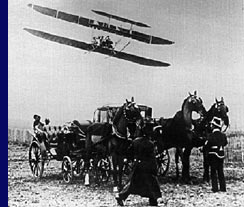 Near
the Place du Jacobins you can see a statue commemorating
the Wright Brothers’ maiden flight. The engine for
their aeroplane was manufactured in Le Mans, and the Wright
brothers' test flight at Le Mans is pictured right.
Near
the Place du Jacobins you can see a statue commemorating
the Wright Brothers’ maiden flight. The engine for
their aeroplane was manufactured in Le Mans, and the Wright
brothers' test flight at Le Mans is pictured right.
Originally
there were no restrictions on driving time or number of
drivers in the 24 our race. In the early 1950s Pierre Levegh,
a Frenchman, attempted the race single handed. He was leading
with less than one hour to go, but destroyed the engine
after messing up a gearchange due to fatigue!!
Tom
Kristensen, who is driving the #2 Audi with Allan McNish
and Dindo Capello, has won the event a record 7 times.
The
only driver to have won the modern quadruple crown of Endurance
Racing – Le Mans 24 Hours, Daytona 24 Hours, Sebring
12 Hours and Road Atlanta ‘s Petit Le Mans is Andy
Wallace
Tommy
Erdos’s class pole position at the 2006 race was one
of a series of 6 consecutive LMP2 pole positions for the
Brazilian in the AD Group MG Lola during 2006

Andy
Wallace won Le Mans at his first attempt in 1988, driving
the TWR Jaguar XJR-9 pictured above. In 17 subsequent visits,
despite many podium finishes, the next time he stood on
the top step of the podium at Le Mans was last year for
his LM P2 class win in the RML AD Group’s MG Lola
!
In
2002 Mike Newton set himself a personal target of competing
at Le Mans by 2007. This year, 2007, will actually be his
fifth consecutive Le Mans start, of which two are class
wins!!
